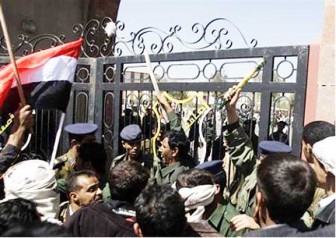PARIS, (Reuters) – Anti-government protests inspired by popular revolts that toppled rulers in Tunisia and Egypt are gaining pace around the Middle East and North Africa despite political and economic concessions by nervous governments.

Clashes were reported in tightly controlled oil producer Libya, sandwiched between Egypt and Tunisia, while new protests erupted in Bahrain, Yemen, Iran and Iraq yesterday.
The latest demonstrations against long-serving rulers came after U.S. President Barack Obama, commenting on the overthrow of Egyptian President Hosni Mubarak, declared: “The world is changing…if you are governing these countries, you’ve got to get out ahead of change, you can’t be behind the curve.”
With young people able to watch pro-democracy uprisings in other countries on satellite television or the Internet, and to communicate with like-minded activists on social networks hard for the secret police to control, authoritarian governments across the region have grounds to fear contagion.
Protests spread across Yemen yesterday demanding an end to the president’s three decades in power, and a 21-year-old demonstrator died in clashes with police in the south, witnesses and medical sources said.
In Sanaa, capital of the Arabian Peninsula state, hundreds of government loyalists wielding batons and daggers jumped out of cars to chase around 800 protesters marching in the streets.
President Ali Abdullah Saleh, a U.S. ally against al Qaeda who has been in power in fractious Yemen for 32 years, was quoted by the state news agency as saying the unrest was a foreign plot to foment chaos in Arab countries.
Saleh has pledged to step down when his term expires in 2013 and offered dialogue with the opposition, but radical protesters are demanding he go now.
In Bahrain, protesters poured into the centre of the capital Manama yesterday for the third successive day to mourn a demonstrator killed in clashes with security forces on Tuesday.
The emirate has a history of protest over economic hardship, the lack of political freedom and sectarian discrimination by the Sunni Muslim rulers against the Shi’ite majority.
Some 2,000 protesters demanding a change of government were encamped at a major road junction in Manama, seeking to emulate rallies on Cairo’s Tahrir Square that toppled Mubarak.
Though itself only a minor oil exporter, Bahrain’s stability is important for neighbouring Saudi Arabia, where oilfields are located in an area populated by an oppressed Shi’ite minority.
DISTURBANCES
AT IRAN FUNERAL
In Iran, supporters and opponents of the hardline Islamic system clashed in Tehran during a funeral procession for a student shot at an anti-government rally two days ago, state broadcaster IRIB reported.
Both sides claimed Sanee Zhaleh was a martyr to their cause and blamed the other for his death.
Monday’s rallies in Tehran and several other Iranian cities were the first staged by the Green pro-democracy movement since security forces crushed huge protests in the months after President Mahmoud Ahmadinejad’s disputed 2009 re-election.
Hundreds of opponents of Libyan leader Muammar Gaddafi, in power since 1969, clashed with police and government supporters in the eastern city of Benghazi yesterday’s early hours, a witness and local media said.
Reports from the port city, 1,000 km (600 miles) east of the capital Tripoli, said protesters armed with stones and petrol bombs set fire to vehicles and fought with police in a rare outbreak of unrest in the oil-exporting country.
Gaddafi’s opponents used the Facebook social network to call for protests across Libya on Thursday.




